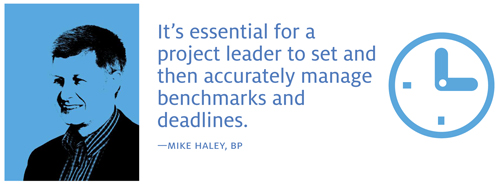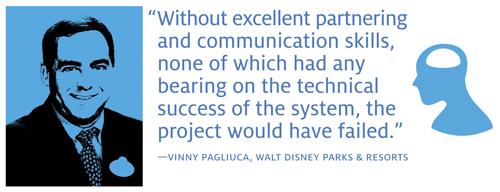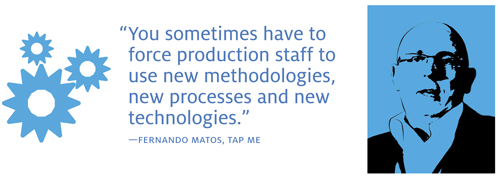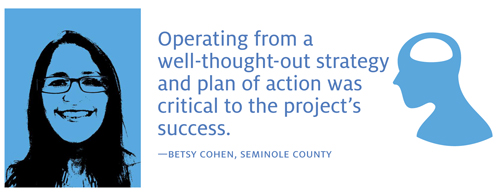Mar 02, 2015"Love and marriage, love and marriage, go together like a horse and carriage. This I tell you brother, you can't have one without the other."
Anyone planning a radio frequency identification project should keep these song lyrics, popularized by Frank Sinatra, top of mind. That's because the success of any company's RFID project—big or small, regardless of industry or application—depends on input from people in both the business and IT departments.
Each side brings key issues and knowledge to the table. The business team knows what problems need to be solved and where inefficiencies occur in the company's processes. It has identified opportunities for using RFID to achieve productivity gains, bottom-line financial benefits and a competitive advantage. The IT team understands the technical issues that must be addressed to meet the business objective.
"Deploying the technology throughout an organization is an ongoing challenge," says Vinny Pagliuca, director of creative costuming at Walt Disney Co., which is using RFID to track and manage costumes at its resorts and on its cruise chips. "There is a need for the IT and business sides of the organization to collaborate effectively."
But effective collaboration is not always easy to achieve. Each team may approach an RFID project without a clear understanding of what the other group requires, egos can emerge, and entrenched silos and turf battles can impede the free flow of information. For optimal results, everyone must begin with a willingness to cooperate and learn what the other team can contribute.
"Organizations that support a more open and connected business and IT environment unlock greater value and better results," says Josh Girvin, senior VP of product management at Atlas RFID Solutions, who has worked with Bechtel and other construction companies on major RFID deployments. "You really want to build a framework that drives adoption of the technology, provides the necessary input and spans three crucial factors: people, processes and technology."
"RFID reaches across silos in an organization," says Sue Flake, director of RFID business development at Zebra Technologies. An established best practice when planning an RFID project is to form a crossfunctional team, with representatives from all areas of the company that will be affected by the deployment. This, of course, includes the business and IT departments.
It's critical to build an enterprise framework for RFID and bring together key business and IT managers, Flake says. Business and IT staff members must feel as though they are on equal footing, she says, though the business side will ultimately drive the project forward. "Their goals must begin to mirror each other," she adds.
Any RFID project requires a formalized communications structure with regular meetings to make sure everyone's on the same page, Flake says. "There's a need for everyone to ask questions, participate and exchange ideas, concerns and whatever seems relevant," she says. "There must be an understanding that there are no bad questions."
An IT representative, for example, must take time to explain how or why something will work—or why it won't work, Flake says. But, she adds, there's no need to drill down to issues on a "bit and byte" basis.

Disney makes it a policy to embed an IT expert within individual business teams and groups, including the costuming department, Pagliuca says. "There is a basic framework for sharing information across the business-IT boundary," he says. This has helped bridge the gap in critical expertise between domains, he explains, and it improves the odds that systems and processes will remain in synch over time.
"We have some extremely knowledgeable technology people working in our department," Pagliuca says. "We could develop a technology solution on our own—and even do some of our own integration and programming. But this probably wouldn't result in the best possible solution. We understand the need to leverage IT expertise. They bring a great deal of value to a project."
Embedding an IT person or staff on business teams is a wise approach, Girvin concurs. "You really need people who can help navigate a team past technical and practical hurdles," he says.
Anita Weissman, project executive at Essintial Enterprise Solutions, which provides IT services and support for U.S. companies, says clearly defining roles and responsibilities was one of the biggest challenges the company faced when it decided to adopt RFID to improve inventory management at its Lewisberry, Pa., warehouse. "We always seem to have some back and forth in our company about who should run projects," she says. "IT often believes it should control them because they are IT initiatives. But in order to deliver value, the focus must be on the functional and operations side."
To ensure all requirements for its RFID project would be met, Essintial formed a crossfunctional team, which included representatives from almost every department in the company, as well as someone from its RFID solutions provider, Iris Software. The team began with the premise that operations would drive the project forward with support from IT and IS.
"IT and IS aren't close enough to the processes, and they don't fully understand what users need," Weissman says. "So we take the position that operations leads and IT is a valuable member of the team." IT and IS were charged with determining how enterprise systems and hardware would support the RFID initiative and ensuring all data captured in the RFID system would flow into the company's enterprise resource planning system, she says. At the same time, the company relied on in-house business analysts to oversee the project, as it does with all major projects. "They have basic IT-IS knowledge," she says. "They are critical because they have the hybrid expertise to bridge the gap" between practical and technical issues.
The RFID team held weekly, sometimes daily, meetings, Weissman says. "We reviewed everyone's tasks and status to determine exactly where we were at and what they needed to do," she says. "In addition, the vendor supplied a lot of critical information because of its past knowledge and experience with implementations."
As with any project, Essintial experienced a few hitches during its RFID implementation. At the onset, for example, the system delivered read rates in the high 70 percent range, which rendered it largely ineffective. "We didn't want to get into finger-pointing," Weissman says. "We just wanted to solve the problems." Iris Software worked with both the IT and business groups to resolve the issues, and within a month, Essintial boosted the read rates to an acceptable 99 percent-plus.

RFID is a business tool that requires considerable IT support—that's another fact everyone involved in an RFID project must remember. It's not uncommon for RFID projects to get lost in features, specs and technical capabilities, experts say. When this happens, the technology can easily frame and hamper business processes rather than introducing fundamentally new and better ways to conduct business.
A strong business case with projected return-on-investment data is a good starting point. "You can't begin to select the right solution and put the right technology in place without knowing exactly how it solves a real-world problem," Girvin says. Yet it's not uncommon for multiple stakeholders to introduce conflicting ideas and goals. Atlas often uses a "workshop approach" that focuses on identifying objectives early on, he says. Once they are clearly and accurately defined, Atlas works with business and IT leaders to ensure they are working in lockstep.
A solid business case incorporates several key issues, says Francisco Melo, VP of global RFID at Avery Dennison Retail Branding and Information Solutions. These include: identifying the underlying problem or opportunity, gauging the benefits and ROI, pinpointing the key stakeholders, defining how IT needs to be involved, identifying the resources required to put the initiative into motion and training employees to use the system correctly. IT can provide input about how the technology will work within an existing IT framework, he says, but that cannot define the entire scope of a project. It might be necessary to upgrade systems and build a more modern data conduit, for instance.
Taking a "holistic view" is essential, Flake agrees. Business and IT leaders must sit down together to address key issues, she says, including: the gap between existing systems and infrastructure and what's needed to support the project; what tools and technologies are needed onsite; how the deployment will affect business partners; what outside assistance is required and what training is necessary.
During this process, the RFID team must determine whether to deploy RFID as a point solution to solve one problem or as an enterprise solution that could support additional applications and could be rolled out to other locations. This decision requires close collaboration between the business and IT teams, says Ken Traub, president of Ken Traub Consulting. The IT department will be responsible for managing any data generated by the RFID system. But data management becomes more critical when the deployment moves from a point solution, in which the data is self-contained and limited in scope, to an enterprise solution, in which it will need to be integrated into various enterprise applications and available for access by numerous business divisions at different locations.
If the RFID team decides to adopt an enterprise approach, the IT people will need to make sure the RFID data flowing to the enterprise level is designed to be leveraged for future projects, Traub says. But, he adds, this could cause tension between competing goals—catering specifically to the needs of the first project versus planning for future applications. The former approach might seem easier, but the latter lays the groundwork for growth, even when it's not clear exactly what might be needed down the road.
Any RFID project will impact how a company conducts business and employees do their jobs. To ensure a project will be successful and the solution will be used as intended, the business and IT teams must sit down together and map out a strategy for dealing with change. This includes analyzing operations and technical processes to understand up front where change will occur—and how to alter job responsibilities, workflows, physical environments and other issues.
Change is inevitable, but it doesn't have to be overwhelming, says Avery Dennison's Melo. The key is being prepared by providing employee education and training. It's also important to communicate wins to workers who are using the new system or to the entire organization. "When people see a benefit and see how it makes their jobs easier or better," he says, "there's typically buy in."

At Disney, business and IT teams work together to create measures and benchmarks that identify paramount performance issues and other critical factors. "When people see numbers, they are a lot less inclined to question the technology," Pagliuca says. "They view it as a success story rather than a vague proposition."
Pagliuca and Melo both acknowledge it's unlikely you'll be able to sell the project to everyone. "There will always be a few people who question the technology," Pagliuca says. At Disney, he adds, more than 45,000 cast members use the technology, and he's aware of only about 100 negative comments or complaints.
Once an organization achieves positive results with RFID, it's smart to design an enterprise architecture detailing how the solution was deployed, Traub says. This is essentially a blueprint of business practices and processes, data formats, hardware and software selections—everything other business and IT divisions, regardless of location, would need to replicate or adapt the solution to their needs. This enables a company to deploy RFID faster, cheaper and better the second and third time, he adds.
Since an enterprise architecture includes information about operations and technology, Traub suggests creating a separate team, with people from both the business and IT sides, to develop and maintain it. In addition, he says, a knowledge repository should provide social business tools that enable people to communicate and collaborate. These could include messaging applications, videoconferencing systems and shared workspaces.
At Disney, the goal is to avoid reinventing the wheel, Pagliuca says. Embedding an IT person on business teams is one way the company facilitates knowledge sharing. In addition, Disney develops road shows and other events to demonstrate and seed the technology in other parts of the organization. "A road show allows us to show other lines of business what is possible," he says. "We are willing to share the technology because, in the end, there's an understanding that it's for the company and not any particular unit or department."
Exposing internal business groups to RFID technology is critical, Melo says. A presentation team should include both business and IT representatives—or at least individuals who have the knowledge to bridge the business-IT chasm. "When people understand what the technology can do and how it works, they are generally a lot more receptive about using it," he points out. "They also think up new use cases and see potential benefits that may not have been previously identified. You want people to be excited about the possibilities and receptive to the technology. This greatly increases the odds of success."
Companies that adopt a strategic framework—giving both business and IT leaders a clear voice—dramatically increase the odds of success, Zebra's Flake observes. "Organizations that have a clear vision, a good project- management framework and teamwork with strong collaboration succeed," she says.
Atlas' Girvin also believes a culture of cooperation and mutual respect, with clearly defined roles and responsibilities, is vital. "Organizations that achieve a high level of success with RFID projects tend to have strong executive sponsorship, well-defined steering committees and crossfunctional teams, excellent internal communication and a dedication to keeping everyone aligned and on track," he says. "Once an organization develops positive momentum, it's a lot easier to build RFID into the framework of the business."

To see how business-IT collaboration works in the real world, consider Lifespan, a group of five hospitals in Providence, Rhode Island.
The business team wanted to automate the time-consuming, paper-based process of recording temperature and humidity levels of refrigerators, freezers and rooms in which pharmaceuticals and blood were stored. Regulatory compliance organizations, such as The Joint Commission and the American Association of Blood Banks, require that hospitals conduct these readings on a daily basis.
Elaine Palm, Lifespan's director of IS infrastructure, suggested adding RFID to the hospitals' existing wireless network infrastructure, because it would be a cost-effective and easily implemented and supported solution. Then, to help develop the business case, Lifespan's IS infrastructure engineering team conducted a proof-of-concept to determine how much time it could save by replacing the manual system with an automated solution.
Palm determined that employees would save more than 35,000 hours per year, which could be spent on more value-added patient- care activities. With clearly defined benefits, ROI and a path to implementation in place, the business team secured management approval and companywide acceptance.
Lifespan deployed a Wi-Fi-based temperature- and humidity-monitoring solution from AeroScout (now Stanley Healthcare) at one of its hospitals in July 2011, and three more of the facilities were RFID-enabled in September. The solution was deployed at the fifth hospital in 2012. Hospital managers also worked with Palm's team to develop and implement a solution for tracking and managing high-value mobile assets. "Relationships and trust," Palm says, "go a long way toward achieving results."

